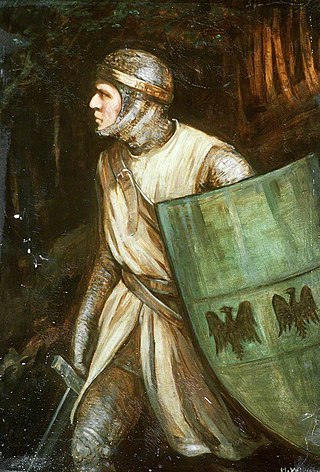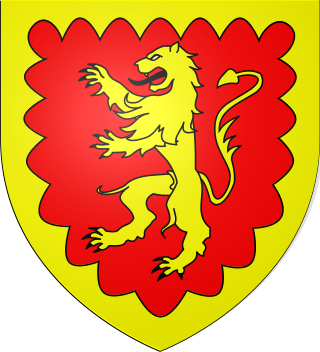Related Research Articles

Owain ap Gruffudd was King of Gwynedd, North Wales, from 1137 until his death in 1170, succeeding his father Gruffudd ap Cynan. He was called Owain the Great and the first to be styled "Prince of Wales". He is considered to be the most successful of all the North Welsh princes prior to his grandson, Llywelyn the Great. He became known as Owain Gwynedd to distinguish him from the contemporary king of Powys Wenwynwyn, Owain ap Gruffydd ap Maredudd, who became known as Owain Cyfeiliog.

Hywel Dda, sometimes anglicised as Howel the Good, or Hywel ap Cadell was a king of Deheubarth who eventually came to rule most of Wales. He became the sole king of Seisyllwg in 920 and shortly thereafter established Deheubarth, and proceeded to gain control over the entire country from Prestatyn to Pembroke. As a descendant of Rhodri Mawr through his father Cadell, Hywel was a member of the Dinefwr branch of the dynasty. He was recorded as King of the Britons in the Annales Cambriæ and the Annals of Ulster.
Gruffydd ap Llywelyn was King of Wales from 1055 to 1063. He had previously been King of Gwynedd and Powys in 1039. He was the son of King Llywelyn ap Seisyll and Angharad daughter of Maredudd ab Owain, and the great-great-grandson of Hywel Dda.

Gruffudd ap Cynan, sometimes written as Gruffydd ap Cynan, was King of Gwynedd from 1081 until his death in 1137. In the course of a long and eventful life, he became a key figure in Welsh resistance to Norman rule, and was remembered as King of all the Welsh and Prince of all the Welsh.

Deheubarth was a regional name for the realms of south Wales, particularly as opposed to Gwynedd. It is now used as a shorthand for the various realms united under the House of Dinefwr, but that Deheubarth itself was not considered a proper kingdom on the model of Gwynedd, Powys, or Dyfed is shown by its rendering in Latin as dextralis pars or as Britonnes dexterales and not as a named land. In the oldest British writers, Deheubarth was used for all of modern Wales to distinguish it from Hen Ogledd, the northern lands whence Cunedda and the Cymry originated.

The Kingdom of Gwynedd was a Welsh kingdom and a Roman Empire successor state that emerged in sub-Roman Britain in the 5th century during the Anglo-Saxon settlement of Britain.

The Kingdom of Powys was a Welsh successor state, petty kingdom and principality that emerged during the Middle Ages following the end of Roman rule in Britain. It very roughly covered the northern two-thirds of the modern county of Powys and part of today's English West Midlands. More precisely, and based on the Romano-British tribal lands of the Ordovices in the west and the Cornovii in the east, its boundaries originally extended from the Cambrian Mountains in the west to include the modern West Midlands region of England in the east. The fertile river valleys of the Severn and Tern are found here, and this region is referred to in later Welsh literature as "the Paradise of Powys".
Idwal Foel or Idwal ab Anarawd was a 10th-century King of Gwynedd in Wales. A member of the House of Aberffraw, he inherited the throne from his father, Anarawd ap Rhodri. William of Malmesbury credited him as "King of the Britons" in the manner of his father.

Maredudd ab Owain was a 10th-century king in Wales of the High Middle Ages. A member of the House of Dinefwr, his patrimony was the kingdom of Deheubarth comprising the southern realms of Dyfed, Ceredigion, and Brycheiniog. Upon the death of his father King Owain around AD 988, he also inherited the kingdoms of Gwynedd and Powys, which he had conquered for his father. He was counted among the Kings of the Britons by the Chronicle of the Princes.
Cynan ap Hywel was a Prince of Gwynedd, one of the kingdoms or principalities of medieval Wales. He was the son of Hywel ap Ieuaf, a previous king from the line of Idwal Foel. On Hywel's death, the realm was ruled by his brother, but almost immediately was seized by Maredudd ab Owain.
Hywel ap Ieuaf was a King of Gwynedd in north-west Wales from 979 to 985.
Iago ab Idwal ap Meurig was a Prince of Gwynedd and Powys. He was also referred to as "King of the Britons" in the Annals of Ulster.

The Royal House of Dinefwr was a cadet branch of the Royal House of Gwynedd, founded by King Cadell ap Rhodri, son of Rhodri the Great. Their ancestor, Cunedda Wledig, born in late Roman Britain, was a Sub-Roman warlord who founded the Kingdom of Gwynedd during the 5th century, following the Anglo-Saxon settlement of Britain. The House achieved the important titles of King of the Britons and Prince of Wales.
This article is about the particular significance of the century 1001–1100 to Wales and its people.
This article is about the particular significance of the century 901–1000 to Wales and its people.

The history of Gwynedd in the High Middle Ages is a period in the History of Wales spanning the 11th through the 13th centuries. Gwynedd, located in the north of Wales, eventually became the most dominant of Welsh polities during this period. Contact with continental courts allowed for Gwynedd to transition from a petty kingdom into an increasingly sophisticated principality of seasoned courtiers capable of high level deplomacy and representation; not only with the Angevine kings, but also the king of France and the Papal See. Distinctive achievements in Gwynedd include further development of Medieval Welsh literature, particularly poets known as the Beirdd y Tywysogion associated with the court of Gwynedd; the reformation of bardic schools; and the continued development of Cyfraith Hywel. All three of these further contributed to the development of a Welsh national identity in the face of Anglo-Norman encroachment of Wales.

The Royal House of Aberffraw was a cadet branch of the Kingdom of Gwynedd originating from the sons of Rhodri the Great in the 9th century. Establishing the Royal court of the Aberffraw Commote would begin a new location from which to rule Wales. The cadet branch achieved the recognised titles of Prince of Wales, King of Wales and were sometimes named King of Aberffraw.
References
- 1 2 The Cambrian Journal. 1859. p. 139.
- 1 2 John Edward Lloyd (1911). A history of Wales: from the earliest times to the Edwardian conquest. Longmans, Green & Co.